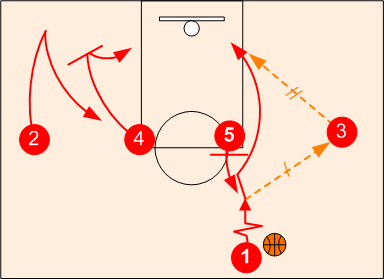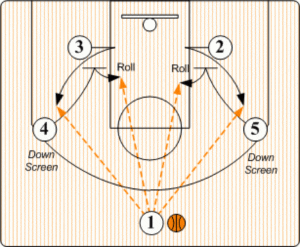Basketball Offense Strategies – Crush your Opponents with the Right Offense
Finding new basketball offense strategies will not make you a championship contender overnight – any play is just a way to organize your team on the court, not a magical formula for winning.
But a good offensive play will help you, position players, where you want them and open up scoring possibilities that will help your team light up those basketball scoreboards.
Spend some time considering how you plan to organize your basketball players before choosing the players you will use.
And realize, of course, that basketball plays are a dime a dozen – a quick search online will pop up dozens of sites, each offering dozens of plays.
But you don’t need dozens – you need two or three. One play that works well against a man-to-man defense, and one that works well against a zone. And maybe one more to mix it up a little. Any more than that and you’ll just confuse your players.
Some players will focus on strengths – e.g., the play will focus on getting your big man open or isolating your star guard. I have nothing against setting up your best scorers, but I don’t like depending on one or two players to carry the game (consider the impact of injuries!).
I like players who give everyone a shot at scoring – the more opportunities, the better it is for everyone. And you never know who will have the hot hand on any given night.
Here are a few possibilities for you, players I have used in the past – and present – that have worked well for me. I’m not showing many, because I don’t use many.
Two well-executed basketball offenses, along with a good fast break and a couple of special-situation players, are all I have time to teach in one season. With that in my playbook and a strong focus on fundamentals, I’m confident my teams can win against the best of opponents.
But I’ll give you my opinion anyway.
Types of Basketball Offense Strategies
The first offense I introduce is the fast break – there are very few teams that won’t benefit from a good fast break, at least on occasion, and I like my teams to use this as our first option.
But as for set basketball offenses, perhaps the first thing to be taught should be a relatively simple shooting drill – the triangle offense. A simple, easy-to-learn drill that teaches the basic movements and shot selection found in many players.
Basketball plays can be divided roughly into two types – Motion Offenses and Continuity Offenses. Basketball Motion offenses follow no specific pattern of movement but rather have players moving according to the situation, adapting to what the defense gives them.
There are rules involved – e.g., whenever you pass you must immediately screen (away or on the ball) – but there is no strict sequence of set movements.
-
Motion Offenses
Motion offenses are often referred to as passing plays and are especially good to use if you are looking for youth basketball players, as they emphasize basic offensive movements and reacting to the situation, good skills to develop in young players.
Check out the offense overview of the passing game before taking a look at the possible offensive movements.
I have become particularly partial to the passing game, and for a variety of reasons, I feel it is one of the best offense strategies I have used, especially with younger teams. In fact, with my junior varsity teams, I very often use nothing but the passing game, along with a couple of in-bounds plays.
-
Continuity Offenses
As for continuity offenses – these are plays that use a set pattern of movement – there are a hundred of those for any situation you are dealing with. Choose continuity plays according to your team’s strengths and abilities.
Do you have a team that is young or inexperienced? This easy basketball play focuses on fundamental movements, is not complex at all, and can be used with young players or with a team that has players capable of playing several positions.
The X is another play that isn’t too difficult, but one that I return to time and again because I find it to be very effective. The X would work best if you have two strong big men, though.
If you have a strong post player that passes well, this spread offense will likely work well for you. Or if you are blessed with a good shooter or two, then try the swing.
Quick players? The shuffle is a great basketball offense strategy to use if your players can cut pick and roll with speed. Or try this basic continuity offense, which features constant cutting and screening.
Another great offense to run with a quick team is the flex offense – effective if you don’t have any big men but you have players that can play several positions.
If you like the flex offense and want to see many more options for running this offense, check out the Complete Book on Basketball’s Flex Offense.
And finally, if you are looking for a good basketball play that is simple to use but effective against almost any zone defense, try the 1-4 Zone Offense. The 1-4 Zone Offense Setup looks at how it can be set up to combat different zone defenses, and on separate pages, you’ll find the Basic 1-4 Offensive Movement and the 1-4 Overload Offense.
These are all good basketball plays and will open up scoring opportunities for your players. They all offer more than one scoring option, as a good play should. And they allow you to reset and run the play several times – as many times as you need to get someone free.
A Few Final Thoughts
A couple of things to remember: first, it is crucial to transition quickly from defense to offense if you are looking for the best opportunities to score – the faster you switch from defense to offense, the more likely your chosen offense will be able to break down your opponent’s defense.
Secondly, remember that patience is a virtue, especially when you are running a set offense – you need to be quick to act on an opportunity to score when it arises, but you don’t want to force a shot or pass or drive that just isn’t there.
And finally, when your team runs these plays in practice, be sure they run them as if in a game situation – solid screens, quick cuts, strong passes, and take the ball to the hole like you mean it.
How they perform in practice is how they’ll perform in the game – it’s a learned response. There’s no “game magic”, except for those spectacular moments when a practiced play is executed perfectly.



